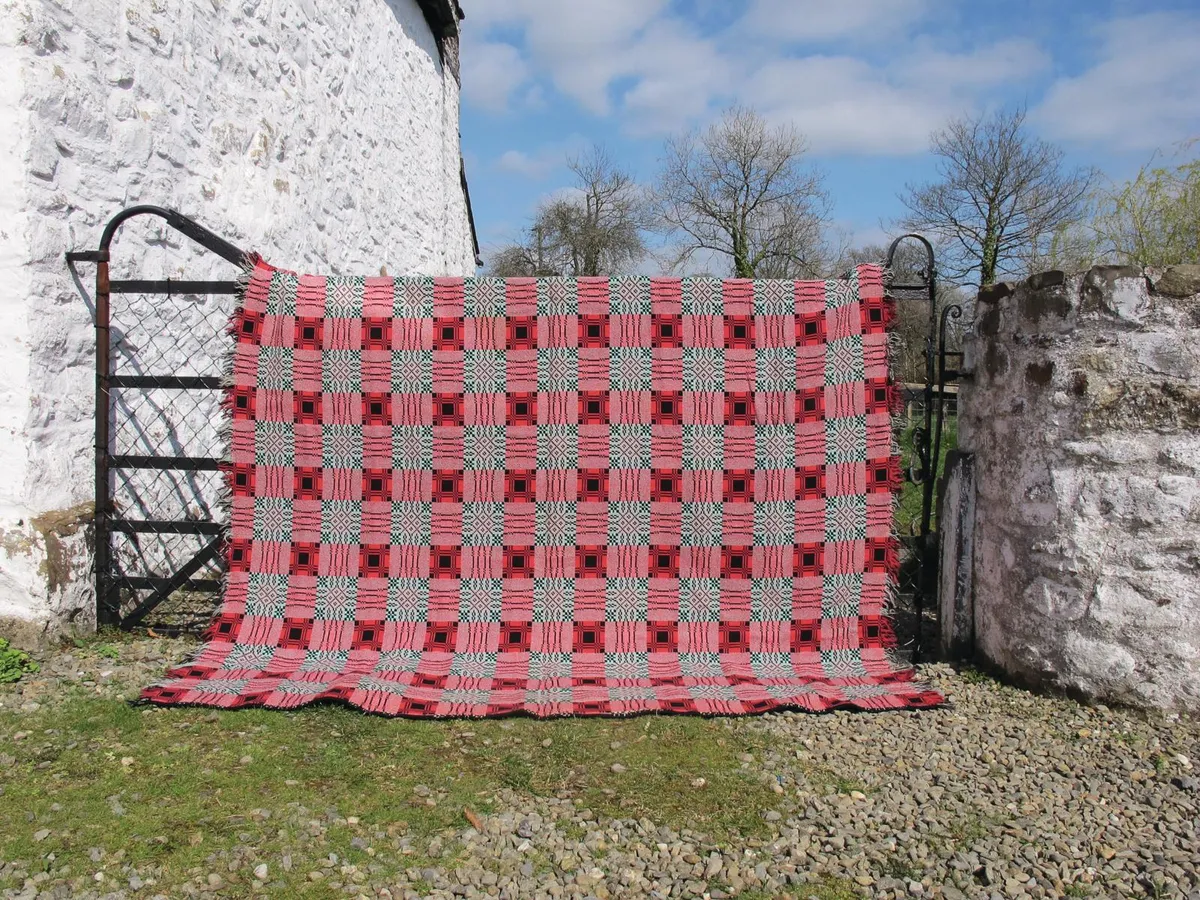Fringed, plaid, striped, tapestry – traditional Welsh woollen blankets once made in the hills and valleys of Carmarthenshire or Ceredigion come in a variety of styles, patterns, colours and sizes.
What is the most distinctive style of Welsh blanket?
The most iconic and distinctive of them all styles of Welsh blanket is the tapestry (or double-weave – a double cloth blanket made by weaving two layers of material together so it is reversible) with its dominant repeat pattern.
Earlier examples from the 19th century were monochrome and usually black and cream or brown and cream, while later mid-century versions were made in bright, lurid colours. Patterns include the chequerboard, the St David’s Cross, and the Caernarfon (or Portcullis). ‘We also call some ‘snowflakes’. There are all sorts as some mills had their own unique patterns,’ says Jen.

What are the most valuable Welsh blankets and how much are they worth?
Illustrated Welsh tapestry blankets with motifs woven in colours such as grey and red or ochre and terracotta on a narrow loom are among the rarest and most expensive blankets. Some from the late 19th and early 20th centuries depicted settings such as Caernarfon Castle. These can sell for around £800-£1,000. Others featured leeks and daffodils. ‘You hardly see early illustrated tapestry blankets but they were made until the 1970s,’ Jen adds.
The different styles of Welsh blanket
Some Welsh blankets are fringed top and bottom. A true carthen or fringed quilt was used as a bedspread as well as a blanket, and surrounded by fringing on all sides. Honeycomb or waffle blankets were also made in the Welsh mills and designed to be warmer.
Some people like to collect the early striped blankets dyed using natural dyes such as indigo or cochineal. These 19th-century blankets tend to be coarser as the mountain conditions and an irregular diet meant sheep indigenous to Wales produced a rough fleece.
Older blankets are also easy to identify because they would have been made on single or narrow looms (the double loom was introduced around 1900) and would have been sewn together to make larger blankets so feature a seam up the middle.
How can you find out the age of a Welsh blanket?
Blankets can also be dated by their colours. ‘Earlier plaids, woven around the turn of the century on narrow looms, were almost invariably strong, dark colours against a natural cream field,’ says Jen. ‘Later plaids, from 1930 to about 1980, used many more colours within each blanket, and there was a great love for pastels. Utility or wartime blankets can be picked out by their specific label (if it’s still attached) and some are surprisingly bright colours.’

What to look for when buying a Welsh blanket
When it comes to buying the right blanket for the right price, condition is key. Look for moth damage in particular. ‘I always pull a blanket over my head and go to a window to look for holes,’ says Jen. ‘Tapestry blankets are hard to repair because of the two different sides. If the blanket is badly damaged and not a good example, we suggest cutting it up for cushions. We sell 20th-century picnic blankets with the odd darn. People don’t mind a neat repair but don’t like stains.’
How to value a Welsh blanket
Size, age and rarity also affect price. ‘We mainly see blankets from the 20th century when a lot of mills were still operating – sadly only half a dozen remain as they have folded one by one since the 1970s.’ Jen says prices can vary from £80-£500 depending on the type and rarity of the blanket, and considerably more for a 19th-century example in good condition. Some tapestry blankets can be found in a pristine state. ‘They were given as wedding presents and often stayed in a drawer wrapped in brown paper.’

Where to buy a Welsh blanket
- Cooling & Cooling
- The Great English Outdoors
- Jane Beck Welsh Blankets
- Jen Jones Welsh Quilts & Blankets
Antiques and flea markets, particularly those in Wales, are good hunting grounds for Welsh blankets. Check out Carmarthen Antiques & Flea Market and Derwen Antiques Fair.